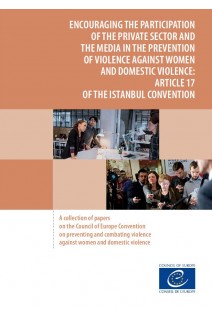



The purpose of this paper is to explain the rationale for the private sector and the media to engage in preventing and combating violence against women and to offer practical advice and good practice examples. Case studies and examples are drawn from a range of employers and organisations, which demonstrate how various interventions and governmental mechanisms can be used to tackle the effects of violence against women and raise awareness of gender-based violence.
Contents
INTRODUCTION
THE SCOPE OF ARTICLE 17
THE RATIONALE FOR THE PRIVATE SECTOR AND THE MEDIA TO ENGAGE IN THE PREVENTION OF VIOLENCE AGAINST WOMEN AND DOMESTIC VIOLENCE
The negative impact of violence against women on businesses and their employees
The link between the media’s portrayal of women and men, their reproduction of gender stereotypes and violence against women
HOW TO ENGAGE THE PRIVATE SECTOR IN PREVENTING AND COMBATING VIOLENCE AGAINST WOMEN AND DOMESTIC VIOLENCE
The involvement of the private sector in its role as employer
The private sector as shaper of attitudes towards women through its goods and services
Engaging the private sector in awareness-raising programmes and victim support
MEDIA AND THE PREVENTION OF VIOLENCE AGAINST WOMEN
Promoting a positive role of the media in preventing violence against women
Preventing violence against women by eradicating gender stereotyping in media reporting
COLLABORATION BETWEEN GOVERNMENTS, THE PRIVATE SECTOR AND THE MEDIA TO PROMOTE MEASURES TO PREVENT VIOLENCE AGAINST WOMEN AND DOMESTIC VIOLENCE
Enhancing the training of media professionals on issues related to gender equality and violence against women
Promoting media self-regulation and regulation of discriminatory and violent content
Partnerships to increase media coverage of gender equality and violence against women
Promoting co-operation on media literacy
CONCLUSION
CHECKLIST
KEY RESOURCES
BIBLIOGRAPHY



The purpose of this paper is to explain the rationale for the private sector and the media to engage in preventing and combating violence against women and to offer practical advice and good practice examples. Case studies and examples are drawn from a range of employers and organisations, which demonstrate how various interventions and governmental mechanisms can be used to tackle the effects of violence against women and raise awareness of gender-based violence.
